 Public interest in campaign news is at the same level as it was at this stage in the 1998 election, and only somewhat lower than in 1994 and 1990. These early September surveys coincide with the conclusion of many local primary races.
Public interest in campaign news is at the same level as it was at this stage in the 1998 election, and only somewhat lower than in 1994 and 1990. These early September surveys coincide with the conclusion of many local primary races.
In addition to comparable public interest in the campaign, other indicators of voter turnout on Nov. 5 are also at roughly the same level as in previous midterm elections. Overall, just as many adults characterize themselves as regular voters, and intentions to vote this year are as high as they were at this time in 1998.
In 1998, however, Republicans were more likely than Democrats to express interest in voting and the campaign; there are no signs of a partisan turnout gap this year. Democrats are just as likely as Republicans to describe themselves as regular voters, and to say they plan to vote this year. Democrats also are slightly more likely to say they are following campaign news very closely.
 When these indicators are combined with voter registration to create an index measuring the likelihood of voting, the increased interest in voting among Democrats becomes even more evident. In both 1998 and 2002, 47% of Republicans were registered to vote and showed a high likelihood of turning out. Among Democrats, this proportion rose from 39% in 1998 to 48% today.
When these indicators are combined with voter registration to create an index measuring the likelihood of voting, the increased interest in voting among Democrats becomes even more evident. In both 1998 and 2002, 47% of Republicans were registered to vote and showed a high likelihood of turning out. Among Democrats, this proportion rose from 39% in 1998 to 48% today.
Bush Motivates Republicans…
President Bush’s popularity has not given Republicans the advantage in the congressional horse race, but he is a bigger political influence particularly for members of his own party than President Clinton was four years ago.
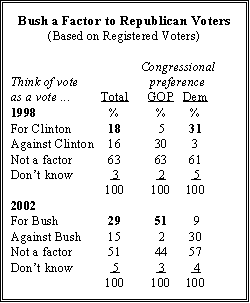 Overall, 29% of registered voters say they think of their ballot as a vote “for” Bush compared with 18% who said that in September 1998, when Clinton was mired in the impeachment scandal. Clearly, Bush is motivating his partisans more than Clinton was able to four years ago. Fully half (51%) of those who currently intend to vote for the Republican candidate in November say their vote is a vote for President Bush. By comparison, just 34% of those voting Democratic in 1998 characterized their vote as a vote for Clinton.
Overall, 29% of registered voters say they think of their ballot as a vote “for” Bush compared with 18% who said that in September 1998, when Clinton was mired in the impeachment scandal. Clearly, Bush is motivating his partisans more than Clinton was able to four years ago. Fully half (51%) of those who currently intend to vote for the Republican candidate in November say their vote is a vote for President Bush. By comparison, just 34% of those voting Democratic in 1998 characterized their vote as a vote for Clinton.
But Has Limited Coattails
The current political environment is vastly different from 1998, yet Bush’s coattails at this stage appear quite similar to Clinton’s. Those who approve of Bush’s job performance intend to vote Republican by 62%-28%; in 1998, Clinton supporters backed the Democratic candidate by a comparable margin (67%-24%).
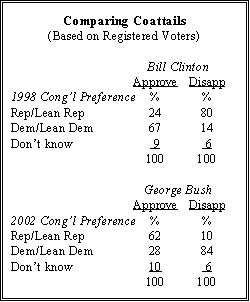 The situation is similar for those who disapprove of the president: currently, 84% of those who disapprove of Bush intend to vote Democratic; four years ago, 80% of those who disapproved of Clinton said they would vote Republican.
The situation is similar for those who disapprove of the president: currently, 84% of those who disapprove of Bush intend to vote Democratic; four years ago, 80% of those who disapproved of Clinton said they would vote Republican.
Democrats More Focused on Control
Democrats are not energized to
vote “against” Bush in especially large numbers, but they are somewhat more influenced by the partisan implications of this year’s congressional races than those intending to vote Republican. Currently, 55% of Democratic voters say the issue of which party controls Congress is a factor in their choice, compared with 49% of Republican voters. This represents a modest gain among Democrats from 1998, when 46% were considering the partisan implications of the race.
But overall, there is no strong evidence that this is a more partisan election than in 1998. Most voters (51%) say the issue of which party controls Congress is not a factor in their choice, down only slightly from 1998 (56%). As in most years, those who identify themselves as Democrats plan to vote for Democratic candidates in congressional races (94%), and the same for Republicans (92%).
Little Change in Party Image
The Democratic party continues to hold an advantage on important domestic issues including Social Security and providing prescription drug coverage. Despite Democratic efforts to make corporate scandals a campaign issue, however, the public gives Republicans a slight edge in dealing with corporate corruption (36%-31%).
Neither party has an advantage when it comes to handling the economy. This represents a decline in the Republican Party’s image on this issue since January (when the GOP was preferred by a margin of 43% to 34%). The shift has been especially notable among independents; in January, independents favored the GOP on the economy by 45%-30%. Now, they are divided (34% Democrats, 32% Republicans).
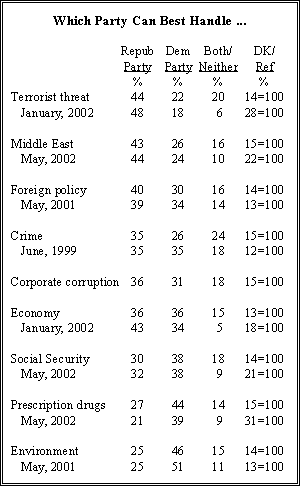 The Republicans are favored on three issues related to military and foreign affairs including dealing with the terrorist threat at home (by 44% to 22%), dealing with problems in the Middle East (by 43% to 26%), and “making wise decisions about foreign policy” (by 40% to 30%). On terrorism and the Middle East, attitudes have been fairly stable this year. But there is a bigger partisan split than at the beginning of the year. Democrats were divided on the terrorism question in January (32% favored Republicans vs. 28% who said Democrats). Now, Democrats back their own party on handling domestic terrorism, 42%-25%.
The Republicans are favored on three issues related to military and foreign affairs including dealing with the terrorist threat at home (by 44% to 22%), dealing with problems in the Middle East (by 43% to 26%), and “making wise decisions about foreign policy” (by 40% to 30%). On terrorism and the Middle East, attitudes have been fairly stable this year. But there is a bigger partisan split than at the beginning of the year. Democrats were divided on the terrorism question in January (32% favored Republicans vs. 28% who said Democrats). Now, Democrats back their own party on handling domestic terrorism, 42%-25%.
The Republicans also hold the edge on reducing crime, with 35% of people saying they are best able to handle this problem compared with 26% for the Democrats. The Democrats had neutralized the Republican advantage on this issue through much of the 1990s.
Democrats maintain the advantage on two other domestic issues, Social Security and prescription drugs. The Democrats hold an eight-point lead on the issue of “taking steps to make the Social Security system financially sound” (38% to 30%). That is largely unchanged since May. Similarly, Republican efforts to craft a prescription drug program for seniors have not changed opinion on this issue (44% prefer the Democrats, 27% the Republicans).
Bush Speeches Impress
The president’s addresses to the nation on the Sept. 11 anniversary were well received, with roughly seven-in-ten (69%) saying he had done an excellent or good job. Even among Democrats, a solid majority (60%) say that the president did at least a “good” job, and 64% of independents agree.
Public reaction to Bush’s U.N. speech also was favorable. Overall, 59% give that speech a positive evaluation, but fewer than half of Democrats (46%) rate it as excellent or good. Men are more likely than women to rate the speech as excellent (28%-19%).
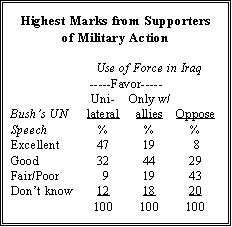 Reaction to the speech is closely related to views about whether and how the U.S. should use force against Iraq. Eight-in-ten (79%) of those who favor military action against Iraq even in the absence of allied support give the speech a positive rating; among those who believe the U.S. should use force only if our allies go along, 63% agree. But among those opposed to the use of force in Iraq, just 37% rate the speech favorably, while 43% give it only a fair or poor rating.
Reaction to the speech is closely related to views about whether and how the U.S. should use force against Iraq. Eight-in-ten (79%) of those who favor military action against Iraq even in the absence of allied support give the speech a positive rating; among those who believe the U.S. should use force only if our allies go along, 63% agree. But among those opposed to the use of force in Iraq, just 37% rate the speech favorably, while 43% give it only a fair or poor rating.
Interest in Iraq Rises
The president is making headway in convincing the nation that the U.S. may need to use force to remove Saddam Hussein from power in Iraq. More Americans are thinking about the issue and more think the president is making a clear case for action. A majority of the public (55%) now say they have thought “a great deal” about whether the U.S. should use military force, an increase of nine percentage points since late August. As in August, men are more likely than women to have thought about the issue (60% vs. 49%).
The biggest increase in attention to the issue has occurred among college-educated respondents, 58% of whom say they have given it a great deal of thought. In August, just 42% of this group gave serious consideration to the idea of taking action against Iraq. By contrast, interest is up only slightly (from 50% to 53%) among those with a high school education or less.
Most Say Bush Making Case
Similarly, a 52% majority now says Bush has explained clearly the stakes in Iraq, up from 37% in late August. As many now say Bush is making the case for military action as said that about his father, President George H.W. Bush, in August 1990 after he had dispatched U.S. forces to the Persian Gulf prior to Operation Desert Storm.
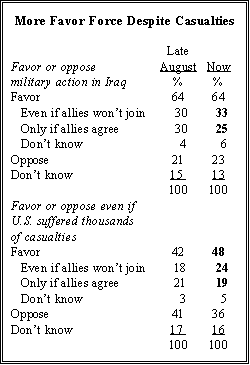 Public support for the use of force in Iraq appears to be growing somewhat more solid. While the number favoring military action is unchanged from late August (at 64%), support is now less dependent upon allied agreement than it was a few weeks ago. Last month, supporters split evenly (30%-30%) when asked if they would still support military action if our allies refused to go along; now, those who would favor a unilateral approach outnumber those who would change their mind in the absence of allied support (33%-25%).
Public support for the use of force in Iraq appears to be growing somewhat more solid. While the number favoring military action is unchanged from late August (at 64%), support is now less dependent upon allied agreement than it was a few weeks ago. Last month, supporters split evenly (30%-30%) when asked if they would still support military action if our allies refused to go along; now, those who would favor a unilateral approach outnumber those who would change their mind in the absence of allied support (33%-25%).
Much of the growth in acceptance of possible unilateral action has come among independents (from 25% in August to 38% now). At the same time, Democrats have become even less supportive, falling from 23% to 13% in favor of attacking Iraq without allied support. Support among Republicans is unchanged (43% now, 41% in August).
The public also has grown slightly more willing to accept significant casualties in Iraq. The number supporting military action in Iraq even with the prospect of thousands of U.S. casualties rose from 42% to 48%. Much of this growth occurred among Republicans (from 58% supportive in August to 66% now), and to a lesser extent among independents (42% in August, 47% now). Both women and men have become more supportive, but the gender gap is as large now as it was last month (currently 57% of men favor military action, even with the prospect of casualties, while 40% of women agree).
Little Evidence of “9/11 Fatigue”
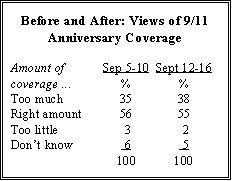 Despite widespread concerns that saturation coverage of the Sept. 11 anniversary might bring about “9/11 fatigue,” Americans generally found the amount of coverage to be appropriate. After all was said and done, fewer than four-in-ten (38%) say news organizations paid too much attention to the events surrounding the first anniversary of the terrorist attacks. This is up only slightly from the week before Sept. 11 (35%).
Despite widespread concerns that saturation coverage of the Sept. 11 anniversary might bring about “9/11 fatigue,” Americans generally found the amount of coverage to be appropriate. After all was said and done, fewer than four-in-ten (38%) say news organizations paid too much attention to the events surrounding the first anniversary of the terrorist attacks. This is up only slightly from the week before Sept. 11 (35%).
People living in the East are somewhat more likely than those in other regions to rate the amount of coverage as appropriate. More than six-in-ten Easterners (64%) say news organizations provided the right amount of coverage, compared with 54% of those in the West and South, and 49% of those in the Midwest.
Did Coverage Help?
Americans are divided over whether the media’s anniversary coverage helped them come to terms with the tragedy. Nearly half (48%) say it helped, while nearly the same number (46%) say it did not help at all.
Those who paid close attention to the coverage are more likely to view it as appropriate and to say that it helped them come to terms with the attacks. Just 21% of those who followed reports dealing with the 9/11 anniversary very closely say the press overdid it, compared to 44% of those who paid little or no attention. And fully 56% of those who followed the news very closely say it helped them to come to terms with the tragedy. By comparison, 59% of those who did not follow the news say the coverage didn’t help them at all.
Kidnappings, Iraq Top Stories
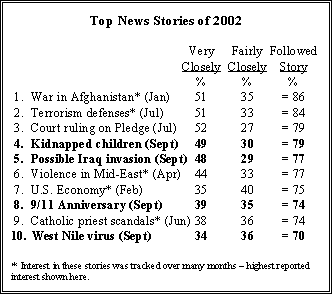 This summer’s child kidnappings and the recent debate over a possible U.S. invasion of Iraq are the month’s top news stories, drawing more public interest than the commemoration of the 9/11 anniversary. Nearly eight-in-ten Americans say they closely followed news of child abductions (79%) and the Iraq debate (77%) with nearly half following these stories very closely placing these among the year’s biggest news stories. There was slightly less interest this month in the 9/11 anniversary story. About three-quarters of the public paid some attention to news of the anniversary, with 39% following it very closely.
This summer’s child kidnappings and the recent debate over a possible U.S. invasion of Iraq are the month’s top news stories, drawing more public interest than the commemoration of the 9/11 anniversary. Nearly eight-in-ten Americans say they closely followed news of child abductions (79%) and the Iraq debate (77%) with nearly half following these stories very closely placing these among the year’s biggest news stories. There was slightly less interest this month in the 9/11 anniversary story. About three-quarters of the public paid some attention to news of the anniversary, with 39% following it very closely.
The child abduction stories have attracted more interest than the Catholic priest scandal, stock market fluctuations, corporate accounting scandals and other major domestic stories. Among this year’s non-terrorism stories, only the controversial federal court ruling on the Pledge of Allegiance drew as much interest. The child kidnappings clearly have struck a chord with women; 57% of women have paid very close attention to this story, compared with 41% of men. Minorities followed this story at higher rates than whites.
The debate over possible U.S. military action against Iraq also drew considerable attention this month. Interest in this story is only slightly less than for the war in Afghanistan at its peak in January and news about U.S. efforts to defend against terrorist attacks, which peaked in July following a flurry of coverage about potential “dirty bomb” attacks. Interest in news about Iraq is higher among men, 55% of whom are following the story very closely, compared with 41% of women.
Nearly three quarters of Americans (74%) followed coverage of the 9/11 anniversary, with 39% paying very close attention. Black and Hispanic respondents paid significantly more attention than whites. The anniversary was also much bigger news to residents of the Northeast than in other parts of the country. Overall, women were slightly more engaged by anniversary coverage than men. A related story the government’s warnings of increased risk of terrorism during the 9/11 anniversary drew somewhat less interest (39% very closely, 29% fairly closely).
News on the spread of the West Nile virus drew attention from seven-in-ten Americans, and there is a strong regional divide in interest to this story. Roughly four-in-ten of those in the South and Midwest (42% and 38%, respectively) followed this story very closely, compared with 31% in the East and just 19% in the West.
Other stories received less attention this month. About six-in-ten (61%) say they tracked stories on corporate scandals, and somewhat fewer (57%) followed news of stock market fluctuations. Less than half of Americans (46%) are following news about candidates and elections in their state and district, which is comparable to news interest at this point in the 1998, 1994 and 1990 midterm election cycles.
Education Gap in News
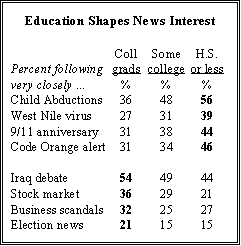 Gender, race and geographic region are all major factors influencing news interest, but education is particularly important. Americans with a high school education or less were far more interested than college graduates in news on child abductions, the West Nile virus, the Sept. 11 anniversary and the Code Orange alert. College graduates, by contrast, paid far more attention to the Iraq debate, stock market fluctuations, business scandals and election news.
Gender, race and geographic region are all major factors influencing news interest, but education is particularly important. Americans with a high school education or less were far more interested than college graduates in news on child abductions, the West Nile virus, the Sept. 11 anniversary and the Code Orange alert. College graduates, by contrast, paid far more attention to the Iraq debate, stock market fluctuations, business scandals and election news.
More than half of those with a high school education (56%) paid very close attention to the child abductions story, compared with 36% of college graduates. When education and gender are factored together, the differences become even more pronounced. Fully 68% women with a high school education or less tracked the child abduction story very closely.


